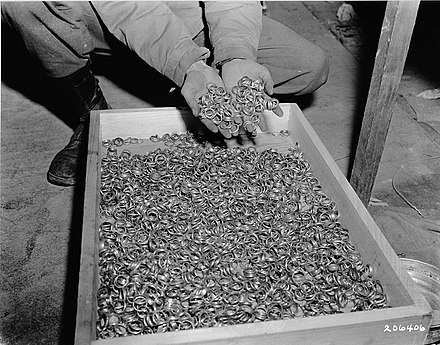Death Mills (or Die Todesmühlen) is a 1945 American-German propaganda film directed by Billy Wilder and produced by the United States Department of War. The film was intended for German audiences to educate them about the atrocities committed by the Nazi regime. For the German version, Die Todesmühlen, Hanuš Burger is credited as the writer and director, while Wilder supervised the editing. Wilder is credited with directing the English-language version; however, he later said that he didn't direct anything as "there was nothing to direct".
The film is a much-abbreviated version of German Concentration Camps Factual Survey, a 1945 British government documentary that was not completed until nearly seven decades later.[1]
The German-language version of the film was shown in the US sector of West Germany in January 1946.[2]

The film opens with a note that the following is "a reminder that behind the curtain of Nazi pageants and parades was millions of men, women and children who were tortured to death – the greatest mass murder in human history," then fades into German civilians at Gardelegen carrying crosses to the local concentration camp.
Most of the film includes footage of the newly liberated camps over a score of stark classical music. The narrator notes that people of all nationalities were found in the camps, including people of all religious or political creeds. There is no mention of the particular fate of Jewish people. The film states that 20 million people were killed and describes many of the now familiar aspects of the Holocaust, including the medical experiments and the gas chambers.
The Orson Welles film The Stranger uses footage of this film during the scene where Edward G. Robinson explains to Mary about Franz Kindler's responsibility for the Holocaust. This film would be included as a supplement on the Kino Lorber Blu-Ray of The Stranger.[3]


Las imágenes de los campos incluyen tomas de montones de cadáveres esqueléticos, sobrevivientes esqueléticos desnudos (a menudo apoyados por otros prisioneros) junto con imágenes de ciudadanos alemanes de aspecto próspero obligados a observar su sufrimiento. Algunos también se ven obligados a transportar los cadáveres para ser enterrados, aunque la mayor parte de este trabajo lo realizaban normalmente ex guardias del campo (como en el campo de concentración de Belsen ).
Hay tomas de fosas comunes, así como de entierros individuales, como en Hadamar , ahora conocido por ser un centro de eutanasia o Action T4 . Algunas de las imágenes parecen ser de origen soviético e incluyen tomas tomadas en el campo de exterminio de Majdanek , que fue uno de los primeros campos liberados en 1944 por el Ejército Rojo . Hay tomas de los crematorios de varios campos, así como de los infames lemas erigidos en las entradas de la mayoría de los campos, como Arbeit macht frei .
Por último, la película muestra los montones de objetos personales robados a las víctimas gaseadas, filmados por los soviéticos cuando liberaron Auschwitz , así como por las tropas estadounidenses en Buchenwald . Incluyen montones de ropa, zapatos, juguetes, anillos de boda y dientes de oro destinados a las bóvedas del Reichsbank .